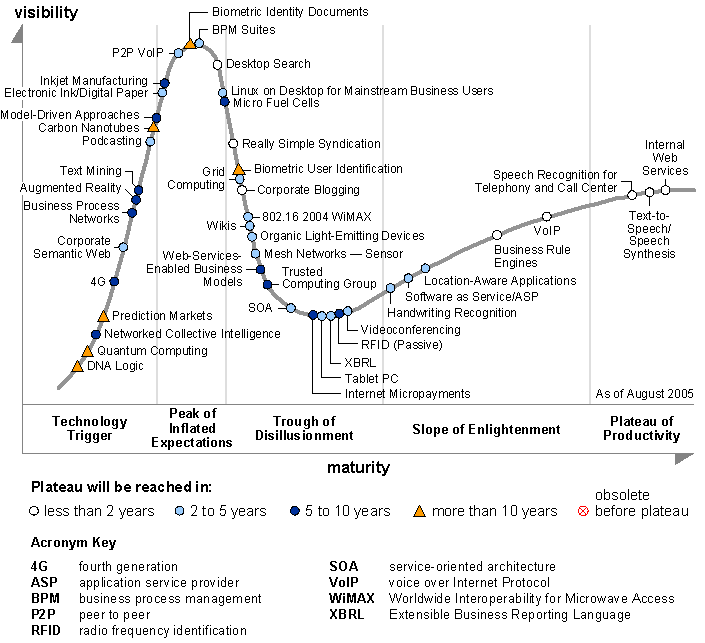January 25, 2007
Embracing Hype
I gave a presentation yesterday on Harnessing New Technologies to an ICT departmental 'teaching strategy' workshop, that also included members of a couple of other groups from the (current) Technology Faculty - Technology Management, the Information Systems MSc team - as well as a couple of members of the Computing department.
One of the slides I showed was a pinched-from-the-web graphic of the Gartner Emerging Technologies Hype Cycle for 2006.
The Hype Cycle structure looks like this:

What I like about this graphical device is that it can be used to illustrate stories. The story I'm working on may or may not have anything to with the Gartner interpretation of the curve, but it works for me. As a story. Sometimes.
Here's how it goes...possibly - I'll make it up as I go along:
Once upon a time (note that once - it means once; it means this is a story) a technological breakthrough made all sorts of new and wonderful things possible.The geeks started to play, the technology was touted as being capable of solving all the world's problems and the media had a field day. The technology only half-worked, of course, but the early adopters were forgiving, partly because they could put up with a bug or two, partly because there were lots of new, low-hanging fruit applications of the technology appearing on a regular basis. And so people could play, and they could see that all the promised really wonderful things were only a matter of time away.
Word got out and the early-middle adopters started to come to the party. The technology still didn't work properly, and the users were not happy bunnies. Word got out again... but a different word this time. Not a nice word. A nasty word.
The techies continued working on the problems, resolving the usability issues, fixing the bugs. The apps came together, reliability improved, and people started using the new applications. Not loudly, quietly.
More people used the apps. And more. A few more each day. Have you tried this? they said to each other.
The apps started to be used. More than that, they started to be used every day. Just every day. You know - one of those things you just use every day. Because they do the job. Not like the first "you HAVE to try THIS" time around. More of "that? Yeah - we use that too" kind of way.
Clink (what's the sound of a light bulb going on?)
Hey guys - you seen this? I can see the headline already: "Technological breakthrough"
Okay - a couple of things about this. Firstly, I wonder about the 'fractal' (self-similar) nature of the Hype Cycle (does the model really work better if you think of it in terms of hype cycles on hype cycles?).
Secondly, I wonder whether or not hype cycle stories can be merged with disruptive technology tales? Does a disruptive technology curve start with a hype cycle whose peak of inflated expectations is the very first foray of the new technology into a market it may later disrupt?
Anyway, anyway - that's off the point.... the point of the post, at least when I started to write it, was - is - to pose the question:
Whether or not you believe that the correctness of the Hype Cycle as a predictive device, a question I keep pondering is: given the timescales over which OU courses are: a) produced, and b) expected to survive, what technologies are the ones we should write about and expect to use within the courses?
That is, when we start looking for subject matter for future ICT courses and curricula, where on the most current hype cycle should we be looking for inspiration?
More on this another day...
Posted by ajh59 at January 25, 2007 08:17 PM